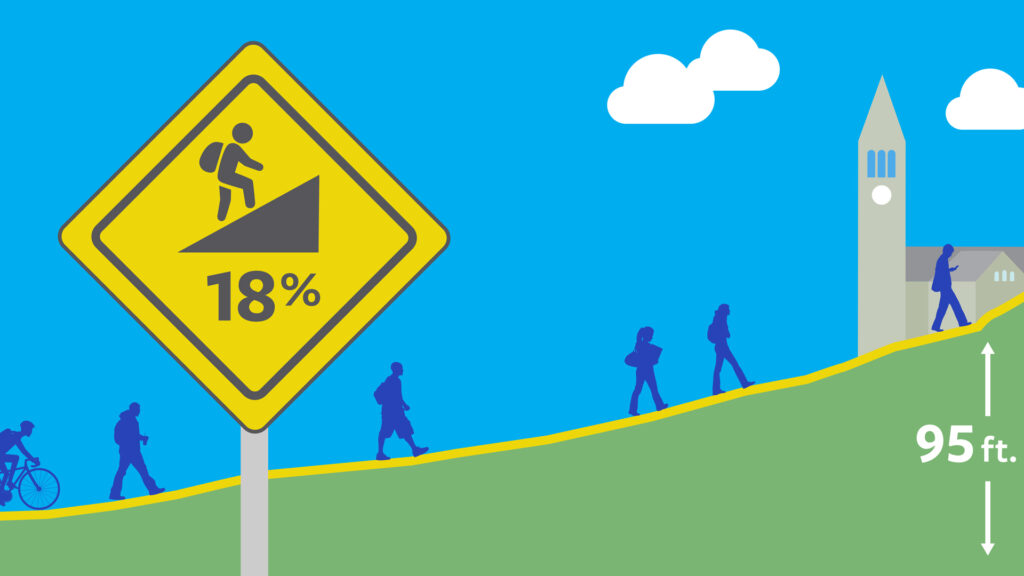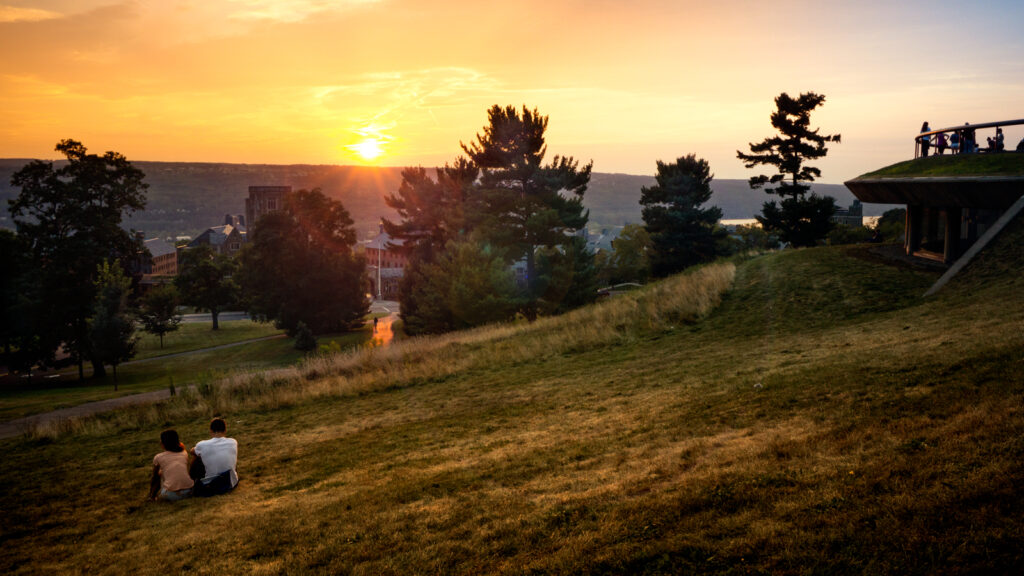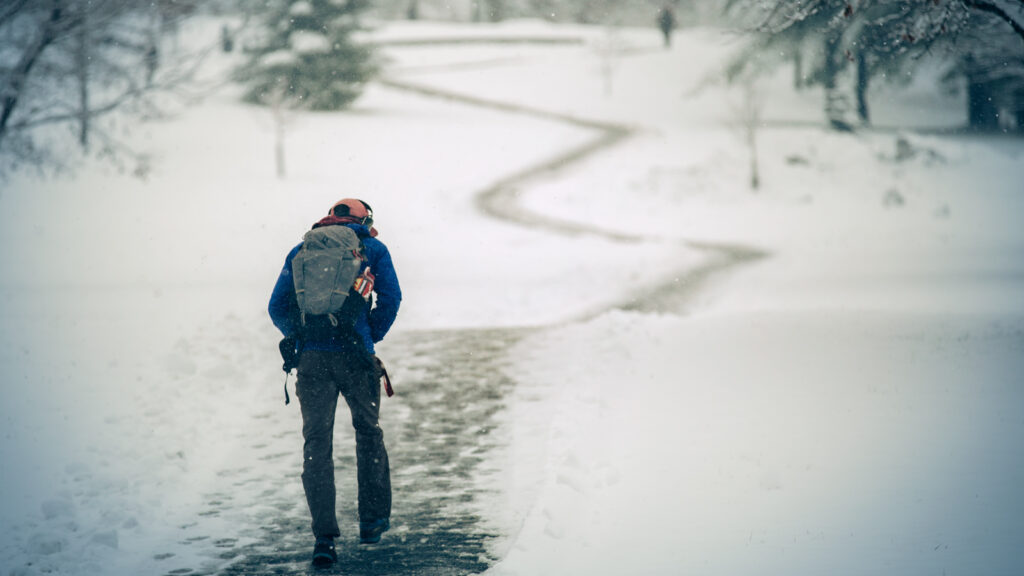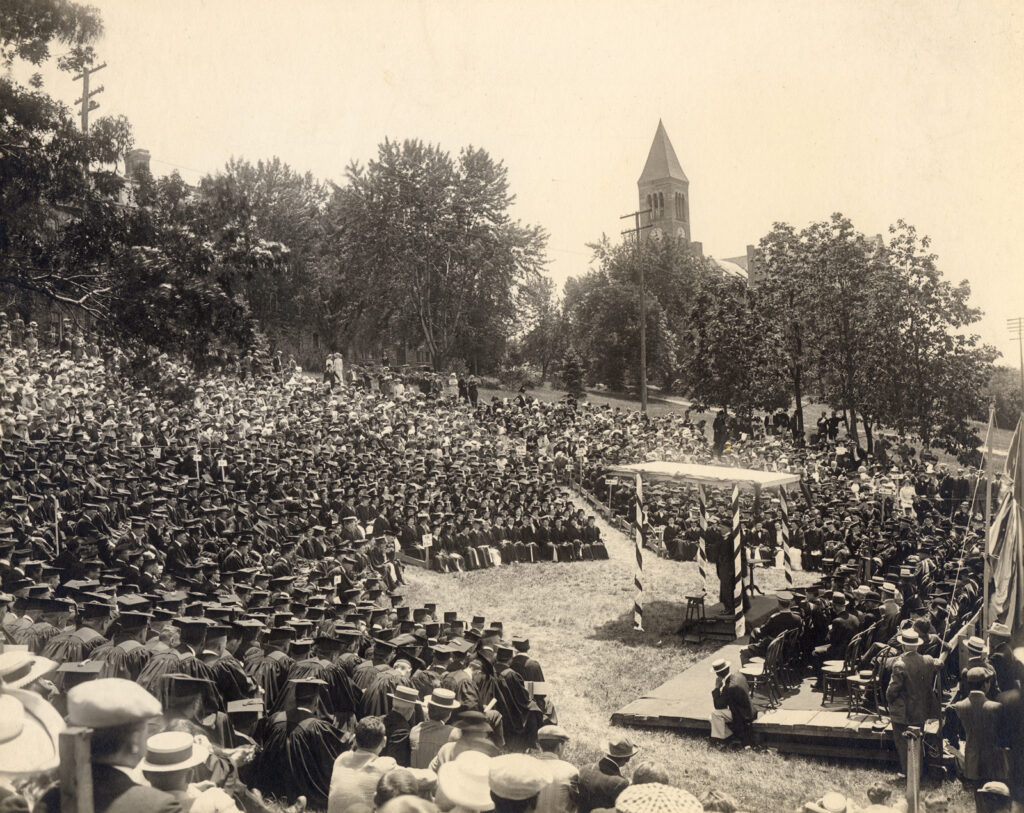East Ridge High School Rochester Ny Art Teacher Degeorge 1970s
Climbing the Gradient is a shared Big Red memory
Past Joe Wilensky
When biomedical engineering major Cali Brady '24 was on her start visit to campus every bit a gymnastics recruit, she watched her future teammates sprint up the Gradient—12 times in a row. "That was very intimidating, because I was out of breath just walking up it for the first time; existence from Illinois where it's very flat, I was non prepared for that," she recalls. "In one case I fabricated information technology on the squad, they told me how difficult information technology really was for them, which fabricated me feel better."
Cornell's landmark hill—officially called Library Slope, more often shortened to Libe Slope or but "the Slope"—has been one of the Academy's defining physical features for more than than a century and a one-half, mark the geographic and altitudinal transition betwixt West Campus and the Arts Quad. For generations of Cornellians, trekking up the Slope to class from West Campus (exist it the U-Halls, Greek houses, co-ops, apartments, or living-learning residential houses) is a shared feel. Educatee and alumni memories of the Slope and its place in campus culture are oft weather-related—from bracingly common cold, icy, or snowy winter mornings to wind and rain to gorgeous autumn evenings, languid late-spring afternoons, and postcard-perfect sunsets.

Over the decades, the Slope has been the site of outdoor Commencements, official physical education activities like skiing—and, of class, Gradient Day. Today, it also reflects the times by hosting swaths of grass left unmowed in an effort toward better sustainability, and the Sesquicentennial Grove (dedicated in 2015) is perched at the top edge for Cornellians to gloat and ponder more than 150 years of University history and its promise for the future.
Ezra'due south 'babyhood delight'
The Slope itself, and the land comprising central campus, is part of a 300-acre swath of farmland between Fall Creek and Cascadilla gorges that Ezra Cornell purchased in 1857 and operated as a farm before donating to the University. (As the University has best-selling with a formal declaration, the packet is located on the traditional homeland of the Gayogo̱hó꞉nǫ', or Cayuga Nation.) According toA History of Cornell past Morris Bishop 1913, PhD 1926, Ezra's commencement memories of the region appointment to adolescence, when he stopped in the area on his fashion to visit an uncle near Geneva. "He remembered his childhood delight with the view from East Hill," Bishop writes. "Cayuga Lake had thrilled him, since he had never seen whatever h2o larger than a millpond."
Decades afterward—in 1865, shortly after the University's charter had been adopted—Ezra brought a few trustees to visit the site to decide where to break basis. Despite the logistical challenges, he wanted to build the kickoff "stone row" of buildings (Morrill, McGraw, and White halls) on the upper site of his farmland rather than the lower, as the meridian border of the ridgeline offered the all-time view of Cayuga Lake and the valley beneath. And the founder got his way. As Bishop writes:
They drove to the hilltop, the present site of Morrill Hall. Ezra Cornell's three companions agreed that the shelf below them would be the ideal situation. 'Young gentlemen,' said Cornell, 'you appear to be because the location of one-half a dozen buildings, whereas some of y'all will live to come across our campus occupied by fifty buildings and swarming with thousands of students.'
'Well, where would you lot build?'
Cornell turned to the east, swung his arms north and south, and said: 'Here, on this line extending from Cascadilla to Fall Creek.'
The iii demurred and argued—Mr. Cornell's solution was not applied. The site, beautiful indeed, was inaccessible, far from the village, rough, gullied, roadless. But Cornell wore them down, and at his management they drove stakes to marking Building No.1.
How steep is it, really?
So do Cornellians' tales and memories of trekking the Slope as students in all kinds of weather condition stand the exam of measurement? While Cornellians may not exist able to convince future generations that it was "uphill in both directions," is information technology exceptionally steep, or does the difficulty of trekking to and from class become exaggerated over time and tinted by nostalgia?
Co-ordinate to University landscape builder David Cutter '84, BS '85, the Slope—measured from West Artery to Central Avenue—covers well-nigh ninety feet of vertical grade. The most direct path from bottom to top, starting time from just exterior Mennen Hall to Central Artery just south of Morrill Hall (the southwestern edge of the Arts Quad) takes that rise over almost 500 horizontal feet, for a class of most 18%. That's pretty steep: a 6% grade is the maximum incline allowed on U.S. federal highways; the metropolis of San Francisco, which is no stranger to hills, allows a maximum 23.1% street grade for bus operations.
And as far as hoofing information technology, the Slope beats out a well-known movie climb: according to Strava (a popular running and cycling app), the 72 "Rocky steps" outside the Philadelphia Museum of Fine art, fabricated famous in the 1976 Sylvester Stallone moving picture and its sequels, average well-nigh a thirteen% grade over 26 feet of acme.

Across Cornell's campus, of form, there is no shortage of steep terrain. Cutter says that for students living on Northward Campus, a climb similar to Libe Gradient would be the path from the Triphammer Dam Footbridge (at the western cease of Beebe Lake, about Tang Welcome Center) to Forest Home Drive and upwardly to Reservoir Avenue in front of Martha Van Rensselaer Hall. That's a vertical rise of 86 feet (although over 760 feet horizontally), for a grade of a fiddling over xi%—"even so pretty steep," he says. In Collegetown, the notoriously steep block of Buffalo Street between Stewart Avenue and Eddy Street also rises 90 feet vertically over most 600 feet horizontally, for a slope of 15%.
A recent test with a fitness watch of 2 brisk walks upwards the Slope (by a volunteer who stands 5 feet, x.5 inches tall) measured two of the nearly direct routes up the Slope, both starting at the War Memorial archway simply west of the Baker Flagpole. The walk upward the Slope to the edge of the Arts Quad between Morrill Hall and Uris Library measured 266 steps over 0.xvi miles and 95 anxiety of elevation proceeds; the other path, from the archway curving to the right of McGraw Tower between the tower and Willard Straight Hall, coming upwardly to the border of Ho Plaza, measured a slightly more than directly 237 steps over 0.fourteen miles—with an elevation proceeds of only 79 feet, since Ho Plaza is slightly downhill from the Arts Quad.
This is actually the steepest sustained climb nigh campus.
Kurt Huebner '21
The Slope equally workout claiming
Kurt Huebner '21, an instructor with Cornell Outdoor Education, points out that the Slope shows up every bit a conditioning on Strava and like apps. While the statistics vary slightly (Strava lists the straightest path up the Gradient every bit 0.one miles and 83 feet of elevation gain for a fifteen.7% average form), the fastest posted time on Strava's leaderboard for sprinting that course is 18 seconds for men and 31 seconds for women.
"I always take those times with a grain of common salt, as many of the varsity runners are not on Strava and the data is only from one platform, so there is no manner of knowing what the bodily fastest time ever done is," Huebner cautions. But, he adds, "this is actually the steepest sustained climb near campus": many of the climbs famous in local biking and running circles are longer but accept a lower class, with both Cascadilla Gorge and Buffalo Street coming in at well-nigh 11%.

Memories run the gamut
On a cute July afternoon, Harry Fuller '21, a master's student in environmental and resource systems engineering, stands most W Campus and the Baker Flagpole and chats with a Cornellians writer about the Slope. Although he never lived on West Campus, he oft went there to swallow during his freshman year—"because the food'southward so much amend down here," he says—and therefore often walked the Gradient.

A right midfielder on the Big Crimson men's soccer team, Fuller as well recalls—not so fondly—the sprints his team would do there. And just during the regular commute up the Gradient on some warmer mornings, "you're drenched by the time y'all're in a classroom," he says—and of course, "in the wintertime, walking up, no matter which manner y'all're going, the wind is somehow always in your face."

For CALS alum Jackie Sepulveda '17, i of her virtually vivid Slope memories is the fourth dimension she raced uphill to get to a chemistry prelim—at dark, in the snow. "It felt like xx-beneath with the wind chill, and I was literally sliding dorsum down the icy Slope equally I walked up it," she says. "Making it to the Concrete Sciences Building at all that night was my victory; I barely remember the examination." Overall, though, Sepulveda recalls happy times in skillful atmospheric condition. "By and large I just remember chilling on the grass, or trying to study on a blanket," she says. "I e'er concluded upwards heedless or falling comatose."
In the winter, walking up, no affair which mode y'all're going, the air current is somehow ever in your face.
Harry Fuller '21
Engineering alum Daniel Mansoor '79, MBA 80, spent iv years traversing the Slope, first as a freshman housed in U-Hall 4 and then every bit a brother living in Sigma Phi fraternity. "I loved the challenge of the daily hike," he recalls. "Reaching the terminate of the climb nearly the archway to Willard Straight Hall, I'd have a deep breath; the remainder of the 24-hour interval would be easier." Scott Pesner '87, who majored in communication in CALS, lived on West Campus his freshman and sophomore years. "Libe Gradient was a big function of my Cornell experience," he says, "at least at the start of the day, when you're very tired and wait up and inquire yourself: 'Tin can I become back to bed?'"
Published Oct 5, 2021
Do you have a retentiveness of the Slope y'all'd like to share? Delight do and so below!
Other posts Y'all may like
Source: https://alumni.cornell.edu/cornellians/uphill-both-ways/
0 Response to "East Ridge High School Rochester Ny Art Teacher Degeorge 1970s"
Post a Comment